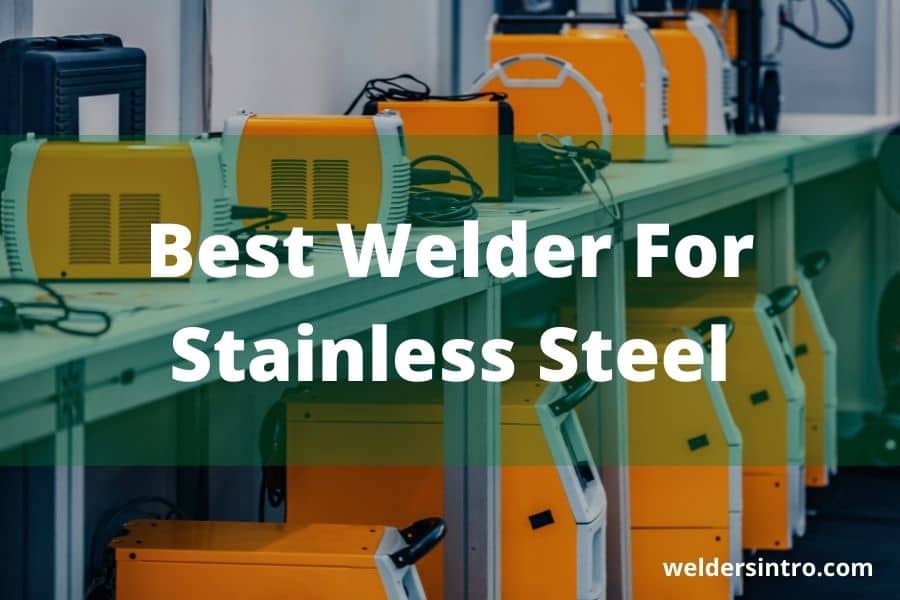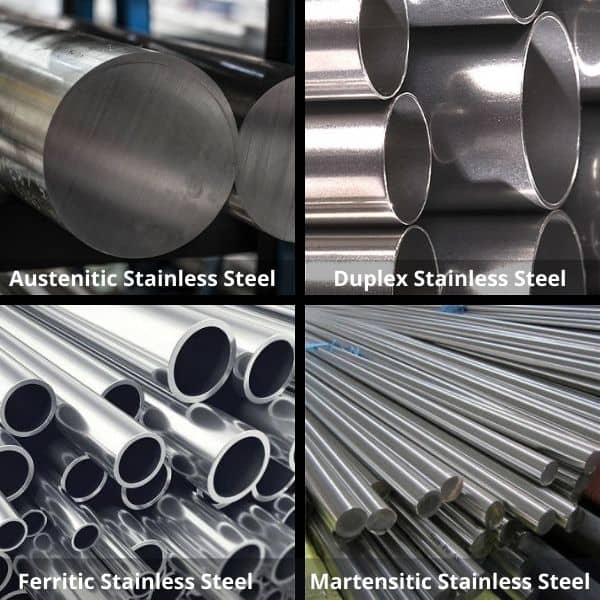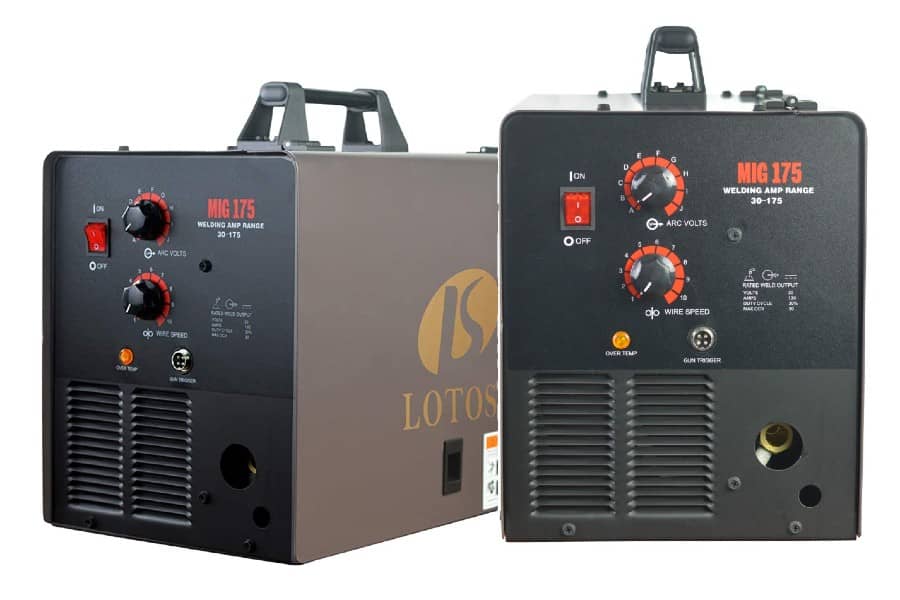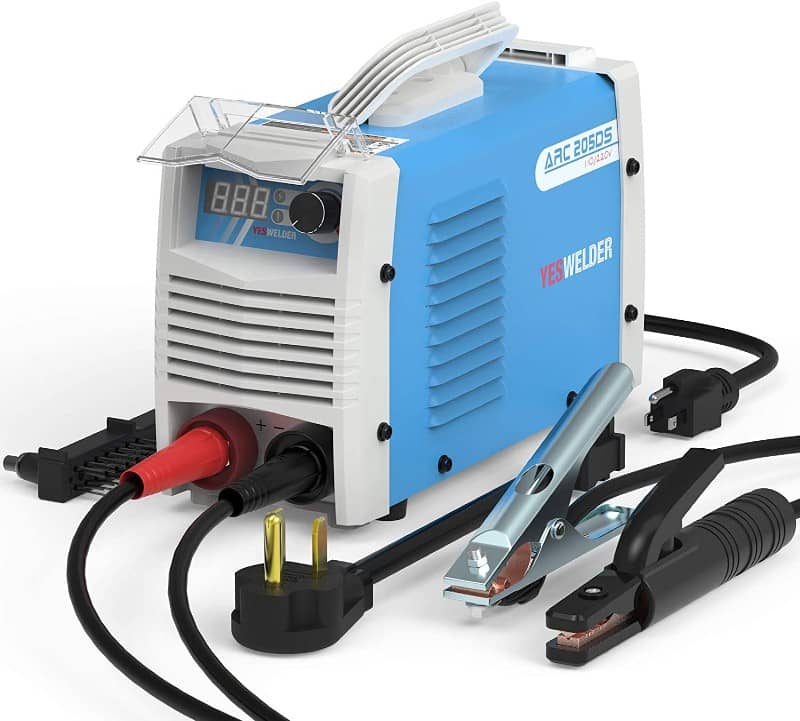Stainless steel is a type of steel alloy that contains at least 10.5% chromium, along with varying amounts of other elements such as nickel, manganese, carbon, and other trace metals. All of these elements make a stainless steel corrosion free metal. The metal lasts for a long time and that’s why it is a popular metal.
Now the question is can you weld stainless steel? And which welder to use to join two stainless steel pieces together?
In this guide I will answer all the questions & suggest some best welder for stainless steel.
Can You Weld Stainless Steel
Yes you can weld stainless steel. Any metal with specific properties can be welded. When you heat the stainless steel to 1400-1530°c (2,550 to 2,790 °F), the metal melts. And after solidification it returns to previous state. And we all know that this property is the fundamental of welding.
Though you may find it difficult to weld stainless steel compared to carbon steel, it can be welded.
Challenges of welding stainless steel
Though you can weld stainless steel, there are few challenges to do so. The challenges are given below-
- Stainless steel is absorbs heat more than any metals. So it causes the metal to retain the temperature applied during welding. As a result it can bent or twisted which we call warping.
- Stainless steel may crack after cooling down. It is due to the high temperature of welding. To reduce the effect you should control the heat during welding. Austenitic steel faces this problem more often due to its properties. And for Martensitic steel, crack appears if the metal is not preheated before welding. Ferritic steel need to be welded with low temperature (300) to prevent the problem.
- If wrongly welded or used wrong tools and materials, the metal can show blemishes or scratches on the surface after solidification.
Checkout Our Best Pick For Best Stainless Steel Welder
- Weldpro Digital 200GD AC/DC Welder (Best multi function welder Foor Stainless Steel)
- Eastwood Tig 200 Amp Dc Welder (Best for thick stainless steel)
- LOTOS MIG175 175AMP Mig Welder (Best mig welder for stainless steel)
- PRIMEWELD TIG/Stick Welder (Best DC tig welder for stainless steel)
- YESWELDER 110/220V Stick Welder (Best stick welder for stainless steel)
- Stark Professional Portable Electric Spot Welder (Best spot welder for stainless steel)
- HZXVOGEN 110V/220V Tig Welder (Best for multiple metals)

1. LOTOS MIG175 175AMP (Best Mig Welder For Stainless Steel)
The welding capacity of Lotos175 is astonishing. You can weld 18 gauge -1/4” of stainless steel using the machine. It contains a transformer which controls the current input which saves electricity and controls the heat input.
The machine contains an aluminum spool gun, a mig torch, a Ground Clamp Cable, Gas Hose, Argon Regulator, 0.023” & 0.035” Contact Tips, 2 lb Steel Wire, and 2 lb Aluminum Wire.
The company is providing 30 day refund policy if the product is not upt o the condition and also provides a 3 year warranty. The performance of this robust mig welder is very satisfying for beginner to intermediate welders
2. Prime weld Tig/Stick Welder (Best DC Tig Welder For Stainless Steel Welding)
TIG200 is an equally impressive as prime weld TIG225X TIG welder, that comes at a relatively lower price tag than its predecessor.
This TIG welder can run at both 110V and 220V, bringing versatility in terms of current input. In addition, a dual pulse frequency setting of 50 and 60 hertz allows the user to have a smooth welding experience.
At the front of the welder, there are quite a few adjustment knobs to fine-tune the welding setting according to your projects. Beside the knobs, there is a digital display that shows the power output of the welder.
Though Primeweld’s TIG200 is not as popular as the TIg225X, it replicates the quality and performance of the mentioned model.
Moreover, it comes with a 3-year warranty which is definitely very hard to overlook.
3. Eastwood Tig 200 Amp Dc Welder
Eastwood TIG 200 is a great option for industrial and garage welding projects. This is a DC welder, and allows you to create the most beautiful joints on 0.25” metal sheets.
The welder has a duty cycle of 60% at 190 AMPS. It is a pretty decent number considering the power.
Though Eastwood TIG 200 is considered high end, the controlling is pretty easy to understand. Whether you are a beginner or a professional welder, you’ll get the hang of it in no time. Additionally, there is a separate switch (4T/2T) for arc operation that adds more convenience to the control.
Eastwood’s TiG 200 also protects the joint from porosity and oxidization with pre and post gas flow.
Overall, Eastwood’s TG 200 is a pretty impressive welder with a decent duty cycle and power numbers. Of course, the price can be a deal-breaker for some, but that doesn’t stop it from being one of the best welders for stainless steel.
4. YESWELDER ARC Welder 205Amp (Best For Stick Welding Stainless Steel)
Looking to stick weld some thick stainless-steel welding? Then Yeswelder 205amp series is the best you can expect.
This option is lightweight and compact. You can carry it anywhere to work on your stainless-steel with ease.
Don’t let the small size and lightweight make you skeptical because this one comes with extreme power. This will surely exceed your expectation in the power segment. You can use it to weld any thickness of stainless steel. You just need to use a suitable stick welding electrode for better result. 6013, 7014 electrodes will do the job.
The price is not that high. If you are in tight budget then this one would definitely be a gem for you.
It has some issues with the arc stability. It doesn’t work well on 120V amperage. So inspect first the voltage of your circuit and then approach to weld.
5. Weldpro Digital Welder (Best Al-Rounder Welder For Stainless Steel)
Whether it’s welding about welding the thin parts or the thick parts of stainless steel, you can do both with the weldpro digital welder. The welder can do both TIG and sticks welding with a single machine. That makes it a best multi function welder.
You can successfully do TIG and stick welding on this one at 120A input voltage. The digital display provides accurate information on settings and time, and the machine is easy to operate.
This is enough to work on 1/8” 7018 electrode. And the welding performance? Smooth as butter.
That takes us to the part where we praise the ease of use aspect of this welder. Along with that it comes with many handy features like AC balance, 2T and 4T settings, foot pedal, and so on. The stability of tig torch and stick electrode holder is commendable.
6. Stark Professional Portable Spot Welder Machine (Best Spot Welder For Stainless Steel)
Often, carrying or using a heavy-duty welder to your job or at DIY projects can pose challenges. So, what can be the solution to this problem?
Well, the Stark portable spot welder machine seem like a one-stop solution that can cover a lot of ground with a simple design.
It’s a beginner-friendly welder that’s capable of handling both professing and DIY projects. The welder is operated through a clamp and release action, allowing you to maintain consistent current flow rates and timing.
The tips of stark professional are six-inch long with durable steel construction to give you the perfect welding result. Additionally, you’ll also get an extra set of contact tips which you can use later. The machine is good for welding thin stainless steel say 16ga or 1/16″.
7. HZXVOGEN 110V/220V (Best TIG Welder For Stainless Steel)
It’s in an affordable price with quality performance. Even with a cheap price tag, this one comes with many functions that will surprise you. Once you fire it up and start welding, the welder feels like a breeze.
Aside from that, it has got excellent DC pulse capability. The 2T and 4T welding settings make this one easy and comfortable to use.
Add all of that up, and you get the best TIG welder for stainless steel prepared for you.
The torch is a little bigger making it hard to hold and weld. However, you can buy a new torch and assemble with the welder easily. Though it will cost extra money for sure, you would feel comfortable to hold and travel the gun smoothly.
Different Grades of Stainless Steel

There are 4 grade stainless steel. They are as follows-
1. Austenitic Stainless Steel
Due to the alloy of iron, duplex steel is highly strong and corrosion resistant. Duplex stainless steel is used mostly for underwater purposes.
Benefits Of Stainless Steel
There are so many benefits you get from using stainless steel. Here are some of them-
- Stainless steel is mostly popular for its corrosion resistance. They don’t get rusty no matter how much you keep them in open atmosphere.
- It is a durable metal
- It is very easy to clean which makes it the best material for kitchen tools and appliances.
- Usually, stainless steel will look aesthetic no matter what you make out of it.
- Weldability, cutting & bending is extremely handy in stainless steel.
Buying Guide For Choosing Best Welding Machine For Stainless Steel
Here are the factors you must consider before buying a welder-
Machine Type For Stainless Metal
You need to choose a welder depending in the projects. If you are planning to weld stainless pipe exhaust, you should go for tig welder. You may use mig welder in this case but make sure you are using proper mig wire for the project.
For welding thicker metal more than 1/4″ use mig welder as mig produces higher heat than tig welder. You may also use stick welder in this case but there is a chance of porosity in this case.
Use spot welder for welding or attaching stainless steel sheet. Using mig or tig in this case can make a burn through problem.
Stainless-Steel Welding Processes (Step By Step)
Here’s how you do it step by step process of welding stainless metal-
- The very first thing you have to do is put on all the protective gear—welding helmet, jackets, safety gloves, masks, welding chaps, boots, everything you have.
- To find out the best filler material for your welding, you will need to look up the AISI code of your base metal.
- Then, start by cleaning the base material properly. You don’t want any oil, rust, or any other contamination there.
- Before you start welding, make sure to keep the base metal stable. For that, you can utilize a welding clamp.
- After that, set up the environment for welding. To do that, you have to feed welding wire to the wire feeder. Make sure to add some shielding gas along with it.
- Here, you will have to check out something. If you go for MIG welding, then you can skip to the next step. But when you are in TIG welding, then you have to configure your welder at this point. For stainless steel, you have to go with DCEN settings.
- Now, you have to set up the torch. You just put the wire inside your torch to get it ready. When you put the electrode inside, check if ¼ inch is visible or not; once it’s done, activate the shielding gas.
- MIG welding uses a 30-degree angle from the joint end. And for TIG welding, use a 75-degree angle on the joint edge. In the case of TIG welding, try not to touch the wire to the joint because that may add up to some extra work.
- To start with the welding process, you have to draw the weld beads now. Draw the lines on the joints to the end. For TIG welding, you will have to feed filler metal constantly every few seconds.
- After drawing all the beads, wait for the metal to cool down. And you are done.
That’s how you can weld stainless steel with both TIG and MIG welders. One thing to keep in mind is the welding spend. Don’t go through the process too fast or too slow. You can occasionally speed up in the thinner areas.
FAQs (Frequently Asked Questions)
1. Is MIG or TIG better for stainless steel?
The choice between MIG or TIG welding for stainless steel depends on various factors, including the application, thickness of the material, desired weld quality, and the skill level of the welder.
If you require efficiency, speedy weld, easy welding and deep penetration, then mig welding is better choice. And you are after precision, clean weld and versatile welding, then Tig welding is better.
2. How hot is a stainless steel weld?
There is no exact answer or this question as there are lots of variants of stainless steel available out there. But if I have to warn you about the safety, keep in mind that the average stainless steel weld temperature can range between 200F to 600F.
3. Why are my stainless steel Turn black After Mig Weld?
There are several reasons why your metal turns black after welding. Here is some potential cause of this discoloration:
a) Inaccurate gas flow
b) Wrong travel direction
c) Using the gun at a wrong angle
d) Incorrect shielding gas
e) Inconsistent travel speed
4. Do I need to preheat stainless steel before welding?
It depends on the metal grade you are using. If you are welding Martensitic steel then preheating is a good option. But for Austenitic preheating can increase the chance of crack after weld is completed. Also Ferritic steel should not be preheated as it is delicate than other steel grade.
5. What are the benefits of preheating stainless steel before welding?
Preheating comes with a few benefits. For example, preheating prevents micro-structure buildup during welding and minimize the area affected by heat. Additionally, it slows down the cooling rate of the welding, which prevents cracking in the welded area.
6. Which stainless steel is easiest to weld?
Among different types of stainless steel, Ferritic steel is known to be the easiest to weld. Almost all the types of steel we know have chromium as well as different alloying elements.
However, in ferritic steel, the presented of these elements are relatively lower, which makes it the easiest steel to weld.
7. What welder is best for stainless steel?
Mig welding is more stronger and solid as well as reliable welding technique for stainless steel. If you are welding thick material then mig welding is best choice. For welding stainless steel sheets, Tig welder is perfect choice.
From my research I have found LOTOS MIG175 as best mig welder for stainless steel & Prime weld tig welder as the best tig welder for stainless steel.
8. What gas do you use for MIG weld stainless?
Argon, helium & carbon dioxide mix is common gas for mig welding stainless steel. Use them at the proportion of 7.5% argon, 90% helium and 2.5% co2.
9. Which type of stainless steel is not weldable?
Martensitic specially 403, 410, and 420 are grades of stainless steel that are difficult to weld. Other than above mentioned Martensitic grade (403, 410, and 420) are nearly impossible to weld.
10. Can you use 100% pure argon for MIG welding stainless?
It is not recommended to use 100% argon in mig welding stainless steel. Because it will produce more spatter and uneven, weak and bad quality weld over the metal.
11. Can you weld stainless steel with normal welder?
You can weld stainless steel with Stick, Tig, Mig, Flux core arc welder even with spot welder. Though each welding technique will produce slightly different output, you can successfully join two metal together.
Last Words
All in all, stainless steel welding isn’t that difficult job. Once you know the process, you can master the it easily. And when you have the best quality welder at hand your work becomes easier.
So try different welder and different type of welding for your project and examine which one best work for you. I would suggest to use a multi-function welder if you are a newbie and don’t want to spend extra bucks for experiment.
Related Articles
Sources:
Like ferritic stainless steel, martensitic stainless steel also comes with some carbon content. However, the amount on this is pretty high about 1% or more.
Having a high amount of carbon makes the metal stronger. Although the metal is strong because of carbon, this also makes it less corrosion resistant than the others.
People mostly use them in pumps and valves.
4. Duplex Stainless Steel
This stainless steel is a combination of austenitic stainless steel and ferritic stainless steel. This kind of fusion makes it stronger than the other two stainless steel. Usually, the nickel component in this steel is lower than austenitic steel. That is why it’s lower priced.
Due to the alloy of iron, duplex steel is highly strong and corrosion resistant. Duplex stainless steel is used mostly for underwater purposes.
Benefits Of Stainless Steel
There are so many benefits you get from using stainless steel. Here are some of them-
- Stainless steel is mostly popular for its corrosion resistance. They don’t get rusty no matter how much you keep them in open atmosphere.
- It is a durable metal
- It is very easy to clean which makes it the best material for kitchen tools and appliances.
- Usually, stainless steel will look aesthetic no matter what you make out of it.
- Weldability, cutting & bending is extremely handy in stainless steel.
Buying Guide For Choosing Best Welding Machine For Stainless Steel
Here are the factors you must consider before buying a welder-
Machine Type For Stainless Metal
You need to choose a welder depending in the projects. If you are planning to weld stainless pipe exhaust, you should go for tig welder. You may use mig welder in this case but make sure you are using proper mig wire for the project.
For welding thicker metal more than 1/4″ use mig welder as mig produces higher heat than tig welder. You may also use stick welder in this case but there is a chance of porosity in this case.
Use spot welder for welding or attaching stainless steel sheet. Using mig or tig in this case can make a burn through problem.
Stainless-Steel Welding Processes (Step By Step)
Here’s how you do it step by step process of welding stainless metal-
- The very first thing you have to do is put on all the protective gear—welding helmet, jackets, safety gloves, masks, welding chaps, boots, everything you have.
- To find out the best filler material for your welding, you will need to look up the AISI code of your base metal.
- Then, start by cleaning the base material properly. You don’t want any oil, rust, or any other contamination there.
- Before you start welding, make sure to keep the base metal stable. For that, you can utilize a welding clamp.
- After that, set up the environment for welding. To do that, you have to feed welding wire to the wire feeder. Make sure to add some shielding gas along with it.
- Here, you will have to check out something. If you go for MIG welding, then you can skip to the next step. But when you are in TIG welding, then you have to configure your welder at this point. For stainless steel, you have to go with DCEN settings.
- Now, you have to set up the torch. You just put the wire inside your torch to get it ready. When you put the electrode inside, check if ¼ inch is visible or not; once it’s done, activate the shielding gas.
- MIG welding uses a 30-degree angle from the joint end. And for TIG welding, use a 75-degree angle on the joint edge. In the case of TIG welding, try not to touch the wire to the joint because that may add up to some extra work.
- To start with the welding process, you have to draw the weld beads now. Draw the lines on the joints to the end. For TIG welding, you will have to feed filler metal constantly every few seconds.
- After drawing all the beads, wait for the metal to cool down. And you are done.
That’s how you can weld stainless steel with both TIG and MIG welders. One thing to keep in mind is the welding spend. Don’t go through the process too fast or too slow. You can occasionally speed up in the thinner areas.
FAQs (Frequently Asked Questions)
1. Is MIG or TIG better for stainless steel?
If you require efficiency, speedy weld, easy welding and deep penetration, then mig welding is better choice. And you are after precision, clean weld and versatile welding, then Tig welding is better.
2. How hot is a stainless steel weld?
3. Why are my stainless steel Turn black After Mig Weld?
a) Inaccurate gas flow
b) Wrong travel direction
c) Using the gun at a wrong angle
d) Incorrect shielding gas
e) Inconsistent travel speed
4. Do I need to preheat stainless steel before welding?
5. What are the benefits of preheating stainless steel before welding?
6. Which stainless steel is easiest to weld?
However, in ferritic steel, the presented of these elements are relatively lower, which makes it the easiest steel to weld.
7. What welder is best for stainless steel?
From my research I have found LOTOS MIG175 as best mig welder for stainless steel & Prime weld tig welder as the best tig welder for stainless steel.
8. What gas do you use for MIG weld stainless?
9. Which type of stainless steel is not weldable?
10. Can you use 100% pure argon for MIG welding stainless?
11. Can you weld stainless steel with normal welder?
Last Words
All in all, stainless steel welding isn’t that difficult job. Once you know the process, you can master the it easily. And when you have the best quality welder at hand your work becomes easier.
So try different welder and different type of welding for your project and examine which one best work for you. I would suggest to use a multi-function welder if you are a newbie and don’t want to spend extra bucks for experiment.
Related Articles
Sources:
This is the most common stainless steel in use. Kitchen cutleries and different storage containers use austenitic stainless steel. Their corrosion resistance is very high and it is popular for its malleability. This metal can withstand extreme heat which makes it a weldable metal.
This kind of steel contains a high amount of nickel. Alongside, there is a generous amounts of chromium and molybdenum as well.
2. Ferritic Stainless Steel
Ferritic are the types of stainless steel that have approximately 0.10% carbon in the composition. The primary element of Ferritic stainless steel is chromium content which makes them highly corrosion-resistant. Ferritic steel contains a large quantity of ferrite which makes them magnetic.
You get to see the use of ferritic stainless steel in kitchenware, car parts, or industrial sectors.
3. Martensitic Stainless Steel:
Like ferritic stainless steel, martensitic stainless steel also comes with some carbon content. However, the amount on this is pretty high about 1% or more.
Having a high amount of carbon makes the metal stronger. Although the metal is strong because of carbon, this also makes it less corrosion resistant than the others.
People mostly use them in pumps and valves.
4. Duplex Stainless Steel
This stainless steel is a combination of austenitic stainless steel and ferritic stainless steel. This kind of fusion makes it stronger than the other two stainless steel. Usually, the nickel component in this steel is lower than austenitic steel. That is why it’s lower priced.
Due to the alloy of iron, duplex steel is highly strong and corrosion resistant. Duplex stainless steel is used mostly for underwater purposes.
Benefits Of Stainless Steel
There are so many benefits you get from using stainless steel. Here are some of them-
- Stainless steel is mostly popular for its corrosion resistance. They don’t get rusty no matter how much you keep them in open atmosphere.
- It is a durable metal
- It is very easy to clean which makes it the best material for kitchen tools and appliances.
- Usually, stainless steel will look aesthetic no matter what you make out of it.
- Weldability, cutting & bending is extremely handy in stainless steel.
Buying Guide For Choosing Best Welding Machine For Stainless Steel
Here are the factors you must consider before buying a welder-
Machine Type For Stainless Metal
You need to choose a welder depending in the projects. If you are planning to weld stainless pipe exhaust, you should go for tig welder. You may use mig welder in this case but make sure you are using proper mig wire for the project.
For welding thicker metal more than 1/4″ use mig welder as mig produces higher heat than tig welder. You may also use stick welder in this case but there is a chance of porosity in this case.
Use spot welder for welding or attaching stainless steel sheet. Using mig or tig in this case can make a burn through problem.
Stainless-Steel Welding Processes (Step By Step)
Here’s how you do it step by step process of welding stainless metal-
- The very first thing you have to do is put on all the protective gear—welding helmet, jackets, safety gloves, masks, welding chaps, boots, everything you have.
- To find out the best filler material for your welding, you will need to look up the AISI code of your base metal.
- Then, start by cleaning the base material properly. You don’t want any oil, rust, or any other contamination there.
- Before you start welding, make sure to keep the base metal stable. For that, you can utilize a welding clamp.
- After that, set up the environment for welding. To do that, you have to feed welding wire to the wire feeder. Make sure to add some shielding gas along with it.
- Here, you will have to check out something. If you go for MIG welding, then you can skip to the next step. But when you are in TIG welding, then you have to configure your welder at this point. For stainless steel, you have to go with DCEN settings.
- Now, you have to set up the torch. You just put the wire inside your torch to get it ready. When you put the electrode inside, check if ¼ inch is visible or not; once it’s done, activate the shielding gas.
- MIG welding uses a 30-degree angle from the joint end. And for TIG welding, use a 75-degree angle on the joint edge. In the case of TIG welding, try not to touch the wire to the joint because that may add up to some extra work.
- To start with the welding process, you have to draw the weld beads now. Draw the lines on the joints to the end. For TIG welding, you will have to feed filler metal constantly every few seconds.
- After drawing all the beads, wait for the metal to cool down. And you are done.
That’s how you can weld stainless steel with both TIG and MIG welders. One thing to keep in mind is the welding spend. Don’t go through the process too fast or too slow. You can occasionally speed up in the thinner areas.
FAQs (Frequently Asked Questions)
1. Is MIG or TIG better for stainless steel?
If you require efficiency, speedy weld, easy welding and deep penetration, then mig welding is better choice. And you are after precision, clean weld and versatile welding, then Tig welding is better.
2. How hot is a stainless steel weld?
3. Why are my stainless steel Turn black After Mig Weld?
a) Inaccurate gas flow
b) Wrong travel direction
c) Using the gun at a wrong angle
d) Incorrect shielding gas
e) Inconsistent travel speed
4. Do I need to preheat stainless steel before welding?
5. What are the benefits of preheating stainless steel before welding?
6. Which stainless steel is easiest to weld?
However, in ferritic steel, the presented of these elements are relatively lower, which makes it the easiest steel to weld.
7. What welder is best for stainless steel?
From my research I have found LOTOS MIG175 as best mig welder for stainless steel & Prime weld tig welder as the best tig welder for stainless steel.
8. What gas do you use for MIG weld stainless?
9. Which type of stainless steel is not weldable?
10. Can you use 100% pure argon for MIG welding stainless?
11. Can you weld stainless steel with normal welder?
Last Words
All in all, stainless steel welding isn’t that difficult job. Once you know the process, you can master the it easily. And when you have the best quality welder at hand your work becomes easier.
So try different welder and different type of welding for your project and examine which one best work for you. I would suggest to use a multi-function welder if you are a newbie and don’t want to spend extra bucks for experiment.
Related Articles
Sources:









5 thoughts on “The 7 Best Welder For Stainless Steel (Tig, Mig & Stick Welder)”